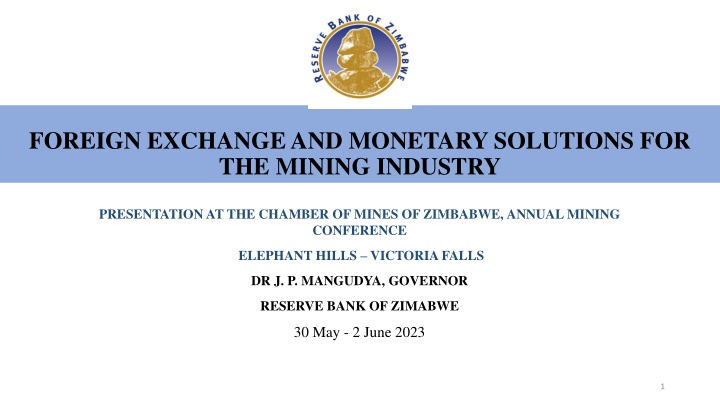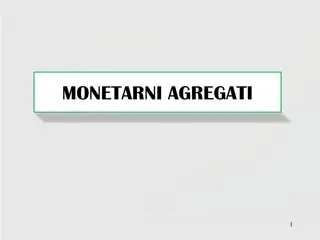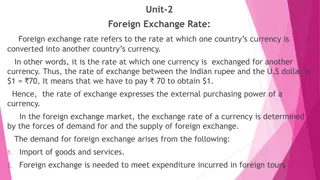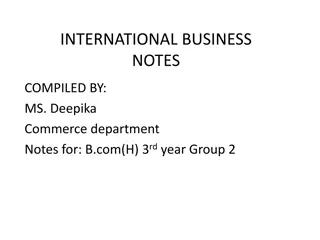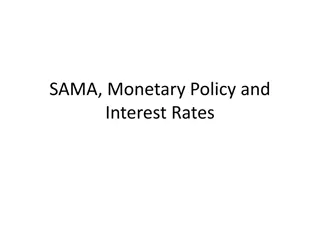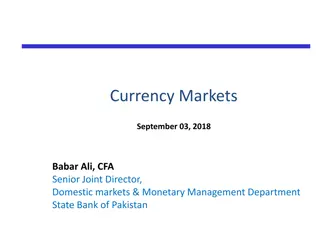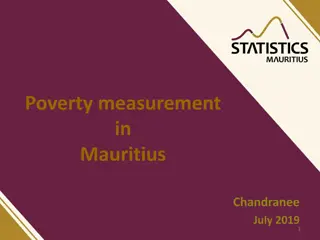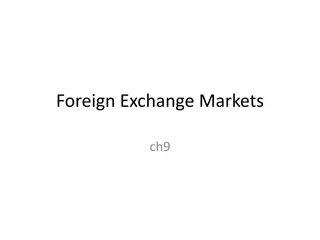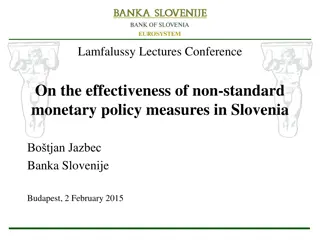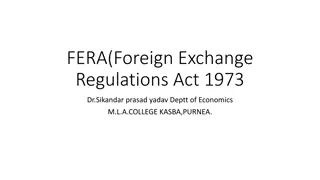FOREIGN EXCHANGE AND MONETARY SOLUTIONS FOR THE MINING INDUSTRY
The mining sector plays a critical role in supporting GDP growth, job creation, and foreign currency generation in Zimbabwe. Investments in minerals like iron ore, lithium, PGMs, and gold are expected to boost the sector further. Mining exports contribute significantly to the country's external sector, supporting the economy's growth despite global and domestic challenges. The sector's impact on foreign currency generation and its role in supporting other sectors through the Auction system are highlighted.
Download Presentation

Please find below an Image/Link to download the presentation.
The content on the website is provided AS IS for your information and personal use only. It may not be sold, licensed, or shared on other websites without obtaining consent from the author.If you encounter any issues during the download, it is possible that the publisher has removed the file from their server.
You are allowed to download the files provided on this website for personal or commercial use, subject to the condition that they are used lawfully. All files are the property of their respective owners.
The content on the website is provided AS IS for your information and personal use only. It may not be sold, licensed, or shared on other websites without obtaining consent from the author.
E N D
Presentation Transcript
FOREIGN EXCHANGE AND MONETARY SOLUTIONS FOR THE MINING INDUSTRY PRESENTATION AT THE CHAMBER OF MINES OF ZIMBABWE, ANNUAL MINING CONFERENCE ELEPHANT HILLS VICTORIA FALLS DR J. P. MANGUDYA, GOVERNOR RESERVE BANK OF ZIMABWE 30 May - 2 June 2023 1
IMPORTANCE OF THE MINING SECTOR The mining sector is critical in supporting GDP growth, job creation and foreign currency generation. The importance of the mining is expected to continue to increase as new investments mainly in iron ore, lithium, PGMs and gold materialise. The mining sector has anchored the country s growth trajectory despite both global and domestic pressures, with the economy expected to surpass the initial growth forecast of 3.8% in 2023. Importantly, the sector has contributed significantly to the foreign currency generation of the country with multiplier effect in the rest of the economy. The increase in exports, mainly mineral exports has supported a favourable external sector since 2019. Total foreign currency receipts reached US$11.6 billion with the bulk coming from mineral exports. Forex from minerals has also allowed importation of strategic products including raw materials and plant and equipment. Through supplying the foreign currency to the Auction system mining sector has enabled the attainment of high and sustained manufacturing capacity utilization at over 56% in 2022 (56% of an expanded base) 2
EXPORTS RECEIPTS Sector Mining Platinum Gold[1] Chrome ore + Ferrochrome Diamonds Other minerals Manufacturing Tobacco[2] Transport Agriculture Horticulture Postal & Telecommunications Other Services (Construction, etc) Tourism Total 2023* 1,388.00 702.6 400 2022 5,627.50 2,269.40 2,462.00 2021 5,011.50 3,019.50 1,210.10 Mining exports account for above 75% of total exports receipts in 2021 and 2022. 52 247.1 173.5 Already up to 30 April 2023, the mining sector contributes about 70% of total exports. 16.6 216.8 52.4 407.1 56.3 37.7 9.9 112.8 536.2 203.1 968.1 157.9 144.6 42.1 244.7 363.7 175.8 575.5 186.9 169.1 40.1 Critical currency be utilised to support other sectors in the economy manufacturing, etc that this foreign 4.9 10.1 27 3 2.5 72.7 31.7 1,991.00 263.6 7,419.50 112.7 6,371.30 3
MINING EXPORTS SUPPORTING ECONOMY WIDE RECOVERY THROUGH FOREIGN CURRENCY AUCTION MAIN AUCTION SMEs AUCTION 30 May 2023 Category/Purpose Raw Materials Machinery and Equipment Retail and Distribution (Incl. Food, Beverages, etc) Consumables (Incl. Spares, Tyres, Electricals) Pharmaceuticals and Chemicals Services (Loans, Dividends and Disinvestments) Paper and Packaging Fuel, Electricity and Gas Amount Allotted (US$) 30-May-23 1,557,807,542.86 726,009,410.12 30-May-23 150,671,992.12 169,083,690.76 Total 1,708,479,534.98 895,093,100.88 353,346,842.47 302,306,529.29 51,040,313.18 379,063,176.28 280,563,597.67 98,499,578.61 218,355,233.95 190,685,048.82 27,670,185.13 304,897,203.90 252,856,447.38 52,040,756.52 104,253,790.83 118,529,197.93 4,082,018,081.21 87,594,002.43 109,270,944.79 3,507,093,523.35 16,659,788.40 9,258,253.14 574,924,557.86 Auction has supported re-tooling by most manufacturing companies Supported growth of SMMEs Importation of strategic products including cooking oil 4
The Banks monetary policy stance, strives to ensure that exporters get a fair value for the surrender portion of their exports. Overly overvalued exchange rate result in an implicit tax to miners on the surrender portion. The refinement to the auction system is designed to reduce the implicit tax. MINING AND MONETARY POLICY SOLUTION 5
OTHER MONETARY POLICY ISSUES The Bank has been maintaining a tight monetary policy stance and the current exchange rate volatility is transitory emanating mainly from: Heightened demand for foreign currency for store-of-value purposes. Self-fulfilling negative inflation expectations hysteresis due to negative past experiences. Growth in credit in the economy is currently under control due to tight monetary conditions. 6
MONEY SUPPLY DEVELOPMENTS Currency Issued 3.69% Money supply remains tight to support stable inflation. Reserve money which is money available for use by the public has been relatively under control at ZW$277 billion of which ZW$180 billion or 65% relates to statutory reserves on foreign currency deposits. Net credit creation by banks has also been under control from the tight monetary policy measures being implemented by the Bank. Excess liquidity which is capable of driving inflation at around ZW$100 million (0.04%) thus money supply is not the key driver of current inflation and exchange rate volatility. RTGS Balances 0.04% Local Currency Statutory Reserves 30.97% Foreign Currency Statutory Reserves 65.30% 7
GROWTH IN ZW$ LOANS HAS BEEN STEADY AND IT IS NOT LIKELY TO BE A MAJOR DRIVER OF INFLATION AND EXCHANGE RATE INSTABILITIES USD and ZW$ LOANS (% Total Loans) 90% 80% 70% 60% 50% 40% ZW$ Loans USD Loans 30% 20% 10% 0% The Bank is aggressively, managing potential risks to the financial sector due to high levels of financial dollarisation in the economy need to prevent high Non-Performing Loans (NPLs) and ensure continued financial stability. 8
GOLD-BACKED DIGITAL TOKENS PRESENT GREAT OPPORTUNITIES FOR STABILISING THE ECONOMY AND INVESTMENT BY MINING HOUSES WITH EXCESS FUNDS Leads to high demand for forex and exchange rate depreciation Excess ZW$ balances available for investment RBZ Issues gold- backed tokenised digital coins in exchange for gold coins/forex/ZW$ Demand for gold-backed digital tokens has been elevated since issuance and is expected to surge on implementation of Stage II Used to purchase foreign currency on the parallel market Red Route ZW$ used to buy gold coins and help mop excess liquidity Green Route A total of 262.92 kgs of digital gold tokens have been issued to date - ZW$30.64 billion. Green Route Consumers exchange gold coins/ZW$/forex for fully backed tradable digital gold tokens issued by RBZ through banks Opportunity for mining houses with excess funds (from surrender portion) for investment. In Phase 2: People can buy goods and services using digital gold tokens kept in digital wallets/payment cards 9
Key Takeaways The Bank s monetary policy stance recognise the importance of the mining sector in the economy. Deliberate and progressive steps have been implemented to ensure a conducive environment to support mining production. Current measures on the auction to allow fair value of the surrender portion of exports is necessary to reduce implicit tax on exports. Managing potential risks to the financial sector due to high levels of financial dollarisation in the economy need to prevent high Non- Performing Loans (NPLs) and ensure continued financial stability. Staying the course of tight monetary policy stance and fiscal sustainability to durably restore and maintain macroeconomic stability. 10
